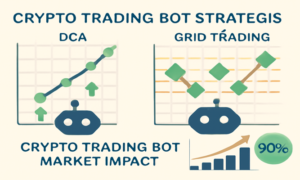Byline: Hannah Parker
Cryptocurrency trading has developed into its own aspect in the financial industry that draws in participants from across the world. As the crypto market matures, so do the resources available to traders. Margin trading is one of these instruments that has drawn much interest because it can improve profits while increasing risk.
Isolated Margin and Cross Margin are two unique approaches that have arisen within the margin trading space. Understanding the differences between them is essential for navigating the environment of the cryptocurrency markets because each offers a distinct method for leveraging your assets.
What is Margin Trading?
Margin trading is a type of financial strategy that enables traders to raise the amount of their market positions by borrowing money, generally from a cryptocurrency exchange or broker. Traders utilise the assets in their accounts as collateral to obtain extra cash rather than depending only on their capital. They can take on bigger positions thanks to this practice, which could also increase their profits, but it also puts them at greater risk.
For instance, with $5,000 you can either buy Bitcoin directly or, by using a leverage ratio of 5:1, you can borrow an extra $20,000, leaving you with $25,000 to invest. After paying back the borrowed money, your $25,000 investment would generate a $5,000 profit, giving you a 100% return on your initial $5,000 investment if Bitcoin’s price increases by 20%.
Crypto developers at Bitcoin Apex website note that margin trading still has dangers. After paying back the borrowed money, your $25,000 investment would decrease to $20,000 in a 20% Bitcoin price drop, representing a 20% loss on your initial $5,000 investment. Remember that this example does not consider trading commissions or interest on borrowed money, which can further reduce profitability.
What is Isolated Margin Trading?
A margin trading strategy known as isolated margin enables traders to designate a specified sum of money as collateral for a particular position. Importantly, this trade has no impact on the remaining balance in their account. This margin separation enables a more regulated risk management strategy by limiting potential losses to the sum allocated as collateral for that deal.
Suppose you want to start a leveraged long position on Ethereum (ETH) with a leverage ratio of 5:1 using a total account balance of 10 BTC. With 2 BTC of your own money and an 8 BTC leveraged position, you effectively trade with 10 BTC of Ethereum. This allocates 2 BTC as the isolated margin for this transaction. Any profits will be added to your initial 2 BTC margin if the price of Ethereum increases and you decide to close the trade. The most you may lose, however, is only your 2 BTC isolation margin if the price of Ethereum decreases dramatically. The remaining 8 BTC in your account are safe even if your position is liquidated, hence the phrase “isolated” margin.
With regulated risk provided by an isolated margin, traders can decide exactly how much money they are ready to risk on each deal while keeping the rest of their money safe. It improves risk assessment and management by making profit and loss computations more transparent. However, it necessitates constant observation to avoid liquidation, and manually altering margin amounts can be challenging, especially for traders managing many positions. Furthermore, separate margins prevent leverage, which impacts profit potential.
What is Cross-Margin Trading?
Cross margin is an alternate margin trading strategy that manages collateral differently from the isolated margin. All the funds in your trading account are used as collateral for your trades when you use cross-margin. This means that the profits from other good positions can be used to cover a loss if one position goes against you and causes a possible loss. Cross margin is frequently preferred since it may enable traders to maintain open positions longer, even when some are underperforming.
Assume you have 10 BTC in your account overall. You initiate two leveraged positions: a leveraged long position on Ethereum (ETH) with a 2:1 leverage and a leveraged short position on Coin X, another cryptocurrency, with a 2:1 leverage. In this case, your 10 BTC account balance will be collateral for both positions.
Let’s imagine Ethereum’s price starts to fall, which could result in a loss for your long position. However, Coin X’s price likewise falls simultaneously, generating a profit for your short position. You can keep both positions open by using the profit from the Coin X transaction to reduce the possible loss from the Ethereum trade.
Cross margin offers better fluidity than isolated margin because it automatically uses the entire account balance to keep open positions from being liquidated. It can be helpful when managing many positions whose performance may cancel one another out, lowering the possibility of individual investments being prematurely liquidated. Total liquidation is possible if several positions struggle and their combined losses exceed the account’s value. Additionally, cross margin makes assigning precise risk-to-reward ratios to each position more difficult, which may result in over-leveraging. Cross margin also reduces control over specific trades. Assessing total risk exposure can sometimes be difficult, especially when several open positions have different profit and loss margins.
Key Differences Between Isolated Margin vs. Cross Margin
With isolated margins, traders can designate a certain portion of their capital as collateral for particular positions, effectively restricting their potential losses to that particular trade. Cross margin uses all of the account’s available cash as collateral for several trades, allowing profits from one position to offset potential losses in another. These systems are ideal for various trading strategies and risk profiles because of their major differences in collateral use, liquidation procedures, risk management, and flexibility.
Traders have access to more advanced tools as the cryptocurrency market develops. Margin trading has gained attention since it uses borrowed money to magnify positions. Two well-known strategies in margin trading – isolated margin and cross margin – offer several ways to leverage assets. Trading with an isolated margin limits potential losses to just one trade by allowing traders to designate specific funds as collateral for individual positions. Cross Margin allows gains from one position to make up for losses in another by using the full account balance as collateral. It’s essential to know these variations to navigate the crypto markets successfully.


































